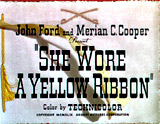
|
She Wore a Yellow Ribbon (1949)
In director John Ford's autumnal and sentimental western,
it was the second of his "cavalry
trilogy" series (and his personal favorite, preceded by Fort
Apache (1948) and followed by Rio Grande (1950) which
were in black and white, and all starring John Wayne); it was filmed
in Ford's favorite scenic locale - Monument Valley; the RKO hit film
was noted for Winton C. Hoch's beautiful Oscar-winning Technicolor
cinematography (the film's sole nomination and win):
- the film's opening narration (voice of Irving Pichel)
described the historical situation in mid-1876 following General
Custer's (and the 7th Cavalry) defeat and 212 dead at the Battle
of the Little Big Horn in Montana, and the departure of Cheyenne,
Sioux and Arapaho Indians from their reservation: "Custer is dead.
And around the bloody guidon of the immortal 7th Cavalry lie 212
officers and men. The Sioux and Cheyenne are on the warpath. By
military telegraph, news of the Custer massacre is flashed across
the long, lonely miles to the Southwest. By stagecoach to the 100
settlements and the 1,000 farms standing under threat of an Indian
uprising. Pony Express riders know that one more such defeat as
Custer's and it would be a hundred years before another wagon train
dared to cross the plains. And from the Canadian border to the
Rio Bravo, 10,000 Indians - Kiowa, Comanche, Arapaho, Sioux and
Apache, under Sitting Bull and Crazy Horse, Gall and Crow King,
are uniting in a common war against the United States Cavalry...And
wherever the flag rises over some lonely Army post, there may be
one man, one captain, fated to wield the sword of destiny"
- in the film's first sequence, a government stagecoach
crossing the remote Southwest desert was robbed of its payroll and
the Paymaster was killed by Cheyenne Indians who had ventured farther
south than usual
- aging, soon-to-be-retired 7th Cavalry captain
Nathan Brittles (John Wayne) was serving at Fort Starke, a one-troop
cavalry post; he had only six days of service left; the entire
area was threatened with a large-scale Native-American
Indian uprising, threatening stagecoaches, settlements, and others
crossing through the territory
- in an early
sunset scene, Capt. Brittles sat at the gravestone of his deceased
33 year-old wife Mary Cutting Brittles, who died in 1867; he spoke
to her while he watered the flowers about his future: "I've
been thinking l'd maybe push on West. New settlements, California"
- the fort was commanded by Major "Mac" Allshard
(George O'Brien), who ordered Brittles (on his last patrol mission)
to protectively accompany two women: his own no-nonsense wife Abby
'Old Iron Pants' Allshard (Mildred Natwick) and Mrs. Allshard's
niece - attractive, genteel single lady Olivia Dandridge (Joanne
Dru); they
were being evacuated for their own safety to an awaiting stagecoach
station at Sudro's Well to take an eastbound stagecoach
- Olivia was being pursued by two rival lieutenants
in the fort: Brittles' pending replacement Lieutenant Flint Cohill
(John Agar) and arrogant 2nd Lieutenant Ross Pennell (Harry Carey,
Jr.); she wore a 'yellow ribbon' in her hair signifying that she
had chosen a "sweetheart" - although the two fought over her affections
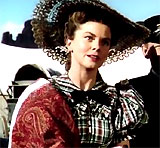
Olivia Dandridge (Joanne Dru)
|
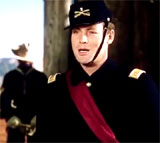
Lieutenant Flint Cohill (John Agar)
|
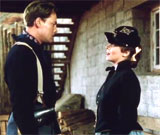
Olivia (Wearing a Yellow Ribbon) with Cohill
|
- Captain Brittles was joined
on the trip by Major Allshard, shrewd chief scout Sgt. Tyree (Ben
Johnson), and often-drunk and comical First Sgt. Quincannon (Victor
McLaglen); the women and the wagons slowed down their trip, and so did a detour when
they had to give a "wide berth" to a group of migrating Arapahos;
along the way, Captain Brittles learned from wounded Cpl. Mike
Quayne (Tom Tyler) that warring Indians (led by radical Arapaho
Chief Red Shirt (Noble Johnson)) had attacked one of the cavalry
patrols near their destination; meanwhile, scout Sgt. Tyree was
pursued by a mounted group of Cheyenne Indians ("Same ones that killed them Yankee soldiers
with General Custer") and was able to escape unharmed by jumping
across a canyon gap
- there was a remarkable, cinematographically-beautiful
dark line of clouds and lightning in a thunderstorm as the cavalry
patrol passed through director Ford's favorite scenic locale -
Monument Valley; at the same time, Cpl. Quayne was successfully operated
upon to remove an arrow in his chest in the back of a wagon
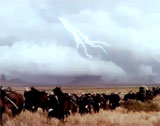
|
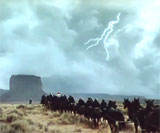
|
|
Remarkable Cinematography
|
- as the regiment approached the Sudro stage depot,
they discovered that the Indians (a mixed group of Cheyenne
and Arapaho) had massacred the stage master John Sudro and his wife Martha (leaving their two
young children Palmer and Carey Sue orphaned), and lethally-wounded,
brave trooper Pvt. John Smith/Rome Clay (Rudy Bowman) who had helped
to defend the depot; Olivia apologized to Capt. Brittles for her part in causing the disaster
and for missing the stagecoach: ("I know all this is because of me.
Because I wanted to see the West. Because I wasn't Army enough to
stay the winter"); a funeral service was held for the deceased
- the patrol was forced to make an arduous, return
march to the Fort, planned for the middle of the night; while departing,
Brittles and others watched from afar as corrupt Indian agent Mr.
Karl Rynders (Harry Woods) and his interpreter were selling $50
rifles to Chief Red Shirt; after making demands of the Indian chief,
the two white men were both killed with arrows; the Indians
opened crates of guns to steal the weapons
- in order to cross the Paradise River unharmed and
to keep the defenses strong against the resurgence of many allied
Indian tribes, Lt. Cohill was ordered to stay behind with two squads
of troops, and as Olivia departed from him, she kissed him - revealing
her romantic choice of sweetheart
- back at the Fort, Captain Brittles told Maj. Allshard
that he considered the mission that he had been leading a complete
failure: "Failed at Sudro's. Failed to keep Rynders' rifles from the tribes. Failed
at everything. I leave the Army a failure"; he expressed his
regret that as an "old soldier" - he was retiring and would lose
all respect and recognition: "Someday, you'll learn how they hate
to give up. Captain of a troop one day, every man's face turned
towards ya. Lieutenants jump when I growl. Now tomorrow, I'll be
glad if the blacksmith asks me to shoe a horse"
- on the next day, his last
day before retirement in a farewell scene, Brittles'
C Troop awarded him with a solid silver pocketwatch with the inscription: "To
Captain Brittles. From C Troop Lest we forget" that
he tearfully and proudly read with his glasses
- after Captain Brittles rode off from the Fort, the
Narrator described the imminent bloody war between the white
and red men: "Signal smokes. War drums. Feathered bonnets against
the Western sky. New Messiahs. Young leaders are ready to hurl
the finest light cavalry in the world against Fort Starke. In the
Kiowa village, the beat of the drums echoes in the pulse of the
young braves. Fighters under a common banner, old quarrels forgotten,
Comanche rides with Arapaho, Apache with Cheyenne. All chant of
war. War to drive the white man forever from the red man's hunting
ground. Only the old men stand silent. Even Pony That Walks has
been howled down at the council fires"
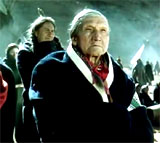
Cheyenne Indian Chief Pony That Walks (Chief John Big Tree)
|
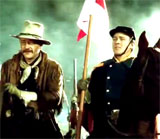
Brittles with Tyree in Indian Camp
|
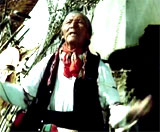
Speaking to Chief Pony That Walks
|
- with only four hours left before his retirement
officially began, Capt. Brittles chose to intervene by meeting (with Sgt. Tyree)
under a truce flag with his elderly friend - Cheyenne Indian Chief
Pony That Walks (Chief John Big Tree); he tried to dissuade the
Indians from war: "My heart is sad at what I see. Your young men
painted for war. Their scalp knives red. The medicine drums talking.
It is a bad thing"; Brittles agreed with the Chief: "Yes, we are
too old for war, but old men should stop wars," but the Chief felt
powerless to do anything against the young war-seeking braves:
"You come with me. We hunt buffalo, get drunk together"
- Brittles chose a risky strategy of stampeding
the Indians' horses out of their camp just before midnight (and just
before his civilian life officially began), to prevent battle in
an inevitable war against US troops, and to force them to return
to their reservation on foot; he felt he had succeeded: "No
casualties, no Indian war, no court-martial"
- then, although officially retired and heading westward
("Westward toward the setting sun, which is the end of the trail
for all old men"), Brittles was recalled back to duty ("But the
Army hadn't fiinished with Brittles") by the Yankee War Department
- with a promotion as Lieutenant Colonel and appointment as Chief
of the Civilian Scouts - all endorsed by Phil Sheridan, William
Tecumseh Sherman and Ulysses Simpson Grant, President of
the USA
- the film ended with Brittles receiving praise from everyone at the Fort; as a celebratory
dance commenced, Brittles walked to the gravesite of his wife to quietly sit
- the Narrator praised the cavalrymen in the film's
epilogue: "So here they are: the dog-faced soldiers, the regulars,
the fifty-cents-a-day professionals riding the outposts of a nation.
From Fort Reno to Fort Apache - from Sheridan to Startle - they
were all the same: men in dirty-shirt blue and only a cold page
in the history books to mark their passing. But wherever they rode
- and whatever they fought for - that place became the United States"
|
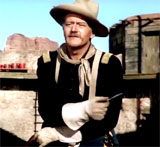
Soon-to-Retire Captain Nathan Brittles (John Wayne)
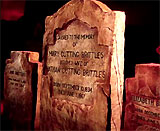
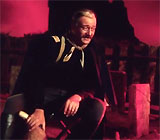
Capt. Brittles at the Grave of His Wife
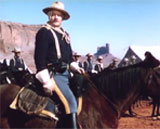
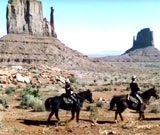
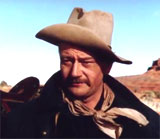
Capt. Brittles' Last Mission - To Take Women to Stagecoach Depot
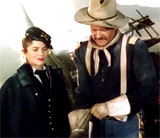
Olivia's Apology to Capt. Brittles
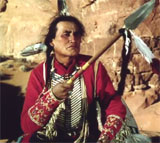
Arapaho Chief Red Shirt On the Warpath
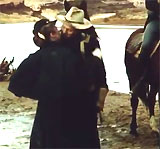
Olivia's Kiss for Cohill, Revealing Her Choice of a Beau
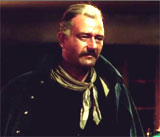
Brittles: "Failed at Everything. I Leave the Army
A Failure"
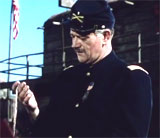
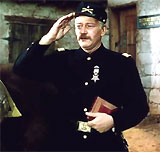
Farewell Scene: A Gift to Brittles of a Silver Pocketwatch
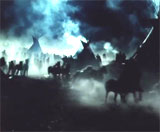
Brittles' Strategy to Prevent War: Stampeding Indians' Horses
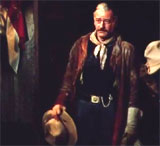
Brittles' Promotion and Return to the Fort After His Retirement
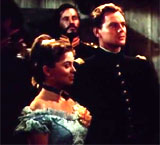
Olivia and Cohill - Now A Romantic Couple
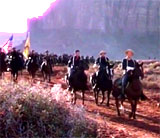
Film's Concluding Epilogue
|

















